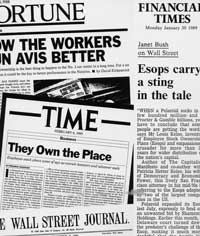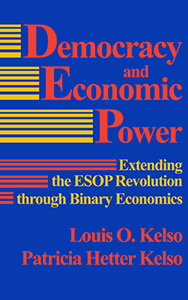In the History of Binary Economics
 1956
1956
Louis Kelso invents the Employee Stock Ownership Plan (ESOP) leveraged buyout to enable employees of Peninsula Newspapers, Inc., of Palo Alto, California, to buy the company from its founders.
1958
Louis Kelso innovates the Consumer Stock Ownership Plan (CSOP) to enable farmers in California’s central valley to become owners of Valley Nitrogen Producers, the fertilizer processing plant of which they are the principal customers.
Louis Kelso goes public with his revolutionary new theory of capitalism in The Capitalist Manifesto, co-authored by Mortimer J. Adler, published by Random House.
1961
The New Capitalists, also by Kelso and Adler, a financial footnote to The Capitalist Manifesto, is published by Random House.
1968
How to Turn 80 Million Workers Into Capitalists on Borrowed Money, followed by paperback edition retitled Two-Factor Theory: The Economics of Reality, co-authored by Louis O. Kelso and Patricia Hetter, published by Random House.
1972
Governor Luis A. Ferre of Puerto Rico introduces the Proprietary Fund for the Progress of Puerto Rico, the first application of Louis Kelso’s proposed General Stock Ownership Plan (GSOP).
1973
Historic meeting between Louis Kelso and Senator Russell B. Long, Chairman of the Senate Finance Committee, at the Montpelier Room of the Madison Hotel, Washington, D.C.
Congress legislatively defines the Employee Stock Ownership Plan (ESOP) for the first time with passage of the Regional Rail Reorganization Act.
1974
The Employee Retirement Income Security Act of 1974 (ERISA), also known as the Pension Reform Act, writes the ESOP into the Internal Revenue Code for the first time.
The Trade Act of 1974 includes a provision which gives preferences on government loans to corporations which use 25% of such loans for ESOPs.
Minnesota becomes the first state to officially encourage the use of ESOPs by passing special tax-benefit legislation under the sponsorship of Senator George S. Pillsbury.
1975
Louis Kelso and the ESOP are featured on “60 Minutes,” with Mike Wallace, broadcast over the CBS television network:
Mike Wallace: “For years, Kelso has been hopping around the country like an itinerant preacher delivering his sermon. He tells anyone who’ll listen what he told the economic leaders assembled by President Ford: that proposals for more tax cuts and more welfare will never solve the economic mess we’re in. They don’t go to the root of the problem.
“Americans,” says Kelso, “are a nation of industrial sharecroppers who work for somebody else and have no other source of income. If a man owns something that will produce a second income, says Kelso, he’ll be a better customer for the things that American industry produces. But the problem is how to get the working man that second income.”
The Tax Reduction Act of 1975 introduces the TRASOP or Investment Tax Credit ESOP.
1976
The Tax Reform Act of 1976 provides further tax incentives for the ESOP.
The Joint Economic Committee of Congress holds hearings on Employee Stock Ownership Plans at which Louis Kelso, among others, testifies.
The Joint Economic Committee of Congress endorses broadened capital ownership as an economic goal for America in its 1976 Joint Economic Report:
“To provide a realistic opportunity for more U.S. citizens to become owners of capital, and to provide an expanded source of equity financing for corporations, it should be made national policy to pursue the goal of broadened capital ownership. Congress also should request from the Administration a quadrennial report on the ownership of wealth in this country which would assist in evaluating how successfully the base of wealth was being broadened over time.”
1978
The Revenue Act of 1978 establishes the General Stock Ownership Corporation (GSOC) in response to the initiative and leadership of Senator Mike Gravel of Alaska.
1984
The Deficit Reduction Act of 1984 provides further tax benefits for ESOPs.
1986
Democracy and Economic Power: Extending the ESOP Revolution, co-authored by Louis O. Kelso and Patricia Hetter Kelso, published by Ballinger Publishing Company.
1990
Louis Kelso interviewed by Bill Moyers on his “A World of Ideas” program televised on the Public Broadcasting System.
1991
Second edition of Democracy and Economic Power: Extending the ESOP Revolution Through Binary Economics published by University Press of America.
1993
First Russian edition of Democracy and Economic Power published by Znania Publishing Company, Moscow, Russia.
1996
First Chinese edition of Democracy and Economic Power published by Nanjing University Press, Nanjing, China.
2000
Second Russian edition of Democracy and Economic Power published by Phoenix Publishing House, Rostov-on-the-Don, Russia.

